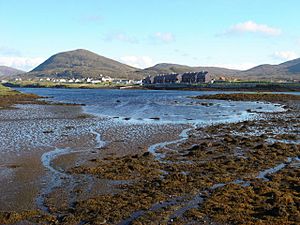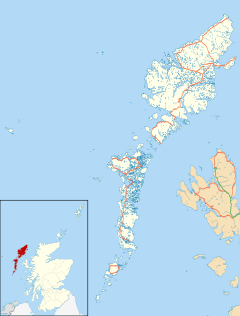Leverburgh facts for kids
Quick facts for kids Leverburgh
|
|
|---|---|
 Most of the houses in Leverburgh are spread out along the eastern side of the A859 |
|
| Language | Scottish Gaelic English |
| OS grid reference | NG014863 |
| Council area | |
| Lieutenancy area | |
| Country | Scotland |
| Sovereign state | United Kingdom |
| Post town | ISLE OF HARRIS |
| Postcode district | HS5 |
| Dialling code | 01859 |
| Police | Northern |
| Fire | Highlands and Islands |
| Ambulance | Scottish |
| EU Parliament | Scotland |
| UK Parliament |
|
| Scottish Parliament |
|
Leverburgh (called An t-Òb in Scottish Gaelic) is a village in Harris, Scotland. It is the second largest village in Harris, after Tarbert. Leverburgh is part of the beautiful Outer Hebrides islands. In 1971, about 223 people lived there.
A Dream for Fishing
A long time ago, in the early 1900s, a rich English businessman named William Lever, 1st Viscount Leverhulme loved the Scottish islands. He bought the Isle of Lewis in 1918. He had a big dream to make the fishing industry there super successful!
But his plan faced problems. After World War I, soldiers came home and wanted land. They started living on plots on the Isle of Lewis. Lord Leverhulme wasn't happy and tried to stop them. But the Scottish government supported the soldiers, and his big plan for Lewis didn't work out.
Building a Fishing Hub
Lord Leverhulme still wanted to help the fishing industry. So, in 1919, he bought land in South Harris. This included a small fishing village called Obbe. Obbe's name comes from a Norse word for a bay.
He had a new idea: turn Obbe into a huge fishing center! He chose this spot because boats could easily reach both the Minch and the Atlantic Ocean. This meant his fishing boats could always find calm waters. He planned for fish to be sent to over 400 Mac Fisheries shops.
In 1920, with local agreement, Obbe was renamed Leverburgh. About 300 workers started building a new pier and buildings along the shore. These buildings were for processing fish caught by many trawlers. They built places for people to stay, sheds for curing fish, smokehouses, and a refrigeration building.
The Project's End
Lord Leverhulme also paid for better roads to handle all the extra traffic. He even planned a second stage to make the inner sea loch a harbor for over 200 trawlers. This new harbor would have a special sea lock to keep the water at a constant depth.
By 1924, Leverburgh was ready to start working. Many herring were caught, and extra workers came from the mainland to help handle the fish.
Lord Leverhulme visited Leverburgh for the last time in September 1924. He then traveled to Africa, where he became ill and passed away in 1925. After his death, the people in charge of his company were not interested in the Leverburgh project. They stopped all the work. The village and its facilities were sold for a small amount of money to a local family.
What Leverburgh Offers
Leverburgh has a Caledonian MacBrayne ferry service. This ferry connects Leverburgh with Berneray. Berneray is then linked to North Uist by a special road called a causeway.
The Post Office in the village opened in 1873. Its name was changed from Obbe to Leverburgh in December 1920.
The area around Leverburgh is famous for its beautiful beaches. You can find many lovely sandy spots, especially along the west coast road.


